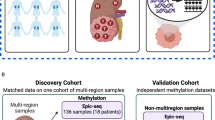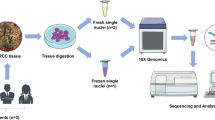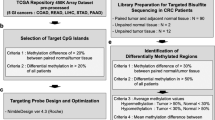Abstract
Recent studies have demonstrated that in clear cell renal cell carcinoma (ccRCC) several chromatin remodeling enzymes are genetically inactivated. Although, growing evidence in cancer models has demonstrated the importance of epigenetic changes, currently only changes in DNA methylation can be accurately determined from clinical samples. To address this limitation, we have applied formaldehyde-assisted isolation of regulatory elements (FAIREs) combined with next-generation sequencing (FAIRE-seq) to identify specific changes in chromatin accessibility in clinical samples of ccRCC. We modified the FAIRE procedure to allow us to examine chromatin accessibility for small samples of solid tumors. Our FAIRE results were compared with DNA-methylation analysis and show how chromatin accessibility decreases at many sites where DNA-methylation remains unchanged. In addition, our FAIRE-seq analysis allowed us to identify regulatory elements associated with both normal and tumor tissue. We have identified decreases in chromatin accessibility at key ccRCC-linked genes, including PBRM1, SETD2 and MLL2. Overall, our results demonstrate the power of examining multiple aspects of the epigenome.
This is a preview of subscription content, access via your institution
Access options
Subscribe to this journal
Receive 50 print issues and online access
$259.00 per year
only $5.18 per issue
Buy this article
- Purchase on SpringerLink
- Instant access to full article PDF
Prices may be subject to local taxes which are calculated during checkout




Similar content being viewed by others
References
Henrique R, Luis AS, Jeronimo C . The epigenetics of renal cell tumors: from biology to biomarkers. Front Genet 2012; 3: 94.
Sonpavde G, Bellmunt J, Schutz F, Choueiri TK . The double edged sword of bleeding and clotting from VEGF inhibition in renal cancer patients. Curr Oncol Rep 2012; 14: 295–306.
Ververis K, Hiong A, Karagiannis TC, Licciardi PV . Histone deacetylase inhibitors (HDACIs): multitargeted anticancer agents. Biologics 2013; 7: 47–60.
O'Rourke CJ, Knabben V, Bolton E, Moran D, Lynch T, Hollywood D et al. Manipulating the epigenome for the treatment of urological malignancies. Pharmacol Ther 2013; 138: 185–196.
van Haaften G, Dalgliesh GL, Davies H, Chen L, Bignell G, Greenman C et al. Somatic mutations of the histone H3K27 demethylase gene UTX in human cancer. Nat Genet 2009; 41: 521–523.
Dalgliesh GL, Furge K, Greenman C, Chen L, Bignell G, Butler A et al. Systematic sequencing of renal carcinoma reveals inactivation of histone modifying genes. Nature 2010; 463: 360–363.
Varela I, Tarpey P, Raine K, Huang D, Ong CK, Stephens P et al. Exome sequencing identifies frequent mutation of the SWI/SNF complex gene PBRM1 in renal carcinoma. Nature 2011; 469: 539–542.
Pena-Llopis S, Vega-Rubin-de-Celis S, Liao A, Leng N, Pavia-Jimenez A, Wang S et al. BAP1 loss defines a new class of renal cell carcinoma. Nat Genet 2012; 44: 751–759.
Cairns P . Renal cell carcinoma. Cancer Biomark 2010; 9: 461–473.
Giresi PG, Kim J, McDaniell RM, Iyer VR, Lieb JD . FAIRE (Formaldehyde-Assisted Isolation of Regulatory Elements) isolates active regulatory elements from human chromatin. Genome Res 2007; 17: 877–885.
Rizzo JM, Buck MJ . Key Principles and Clinical Applications of "Next-Generation" DNA Sequencing. Cancer Prev Res (Phila) 2012; 5: 887–900.
Simon JM, Giresi PG, Davis IJ, Lieb JD . Using formaldehyde-assisted isolation of regulatory elements (FAIRE) to isolate active regulatory DNA. Nat Protoc 2012; 7: 256–267.
Gaulton KJ, Nammo T, Pasquali L, Simon JM, Giresi PG, Fogarty MP et al. A map of open chromatin in human pancreatic islets. Nat Genet 2010; 42: 255–259.
Bibikova M, Barnes B, Tsan C, Ho V, Klotzle B, Le JM et al. High density DNA methylation array with single CpG site resolution. Genomics 2011; 98: 288–295.
Lai WK, Bard JE, Buck MJ . ArchTEx: accurate extraction and visualization of next-generation sequence data. Bioinformatics 2012; 28: 1021–1023.
Wang H, Maurano MT, Qu H, Varley KE, Gertz J, Pauli F et al. Widespread plasticity in CTCF occupancy linked to DNA methylation. Genome Res 2012; 22: 1680–1688.
Zhang Y, Liu T, Meyer CA, Eeckhoute J, Johnson DS, Bernstein BE et al. Model-based analysis of ChIP-Seq (MACS). Genome Biol 2008; 9: R137.
Ernst J, Kheradpour P, Mikkelsen TS, Shoresh N, Ward LD, Epstein CB et al. Mapping and analysis of chromatin state dynamics in nine human cell types. Nature 2011; 473: 43–49.
Eisen MB, Spellman PT, Brown PO, Botstein D . Cluster analysis and display of genome-wide expression patterns. Proc Natl Acad Sci USA 1998; 95: 14863–14868.
Quinlan AR, Hall IM . BEDTools: a flexible suite of utilities for comparing genomic features. Bioinformatics 2010; 26: 841–842.
Cancer Genome Atlas Research Network, Comprehensive molecular characterization of clear cell renal cell carcinoma. Nature 2013; 499: 43–49.
Acknowledgements
This research was supported in part by the National Cancer Institute at the National Institutes of Health (P30CA016056; to RP), a grant from the RPCI -Alliance Foundation (to RP) and a donation from the, The Bruce Cuvelier Family Trust (to RP).
Author information
Authors and Affiliations
Corresponding authors
Ethics declarations
Competing interests
The authors declare no conflict of interest.
Additional information
Supplementary Information accompanies this paper on the Oncogene website
Rights and permissions
About this article
Cite this article
Buck, M., Raaijmakers, L., Ramakrishnan, S. et al. Alterations in chromatin accessibility and DNA methylation in clear cell renal cell carcinoma. Oncogene 33, 4961–4965 (2014). https://doi.org/10.1038/onc.2013.455
Received:
Revised:
Accepted:
Published:
Issue date:
DOI: https://doi.org/10.1038/onc.2013.455



